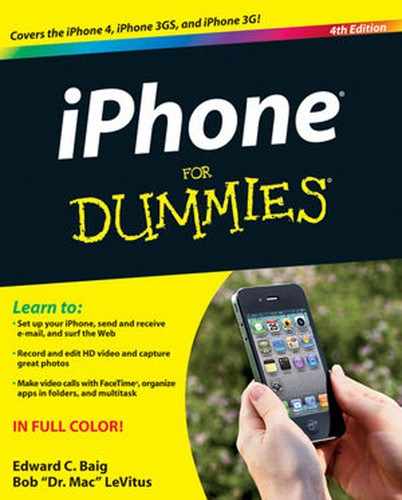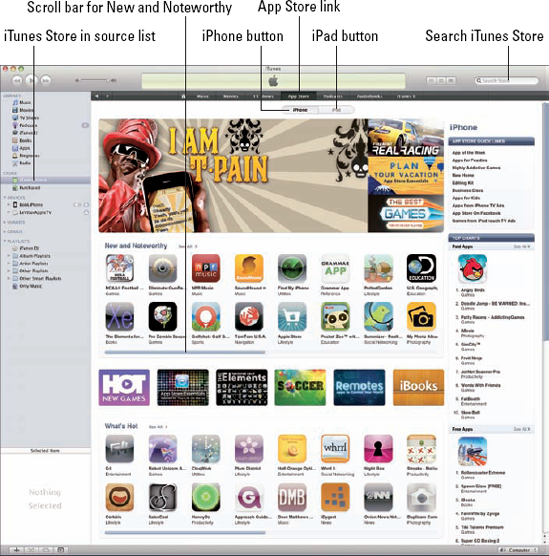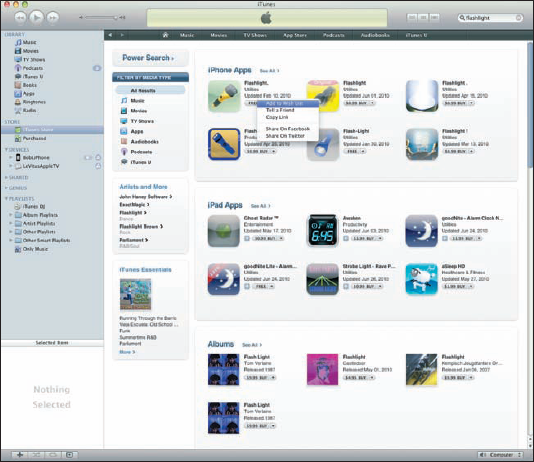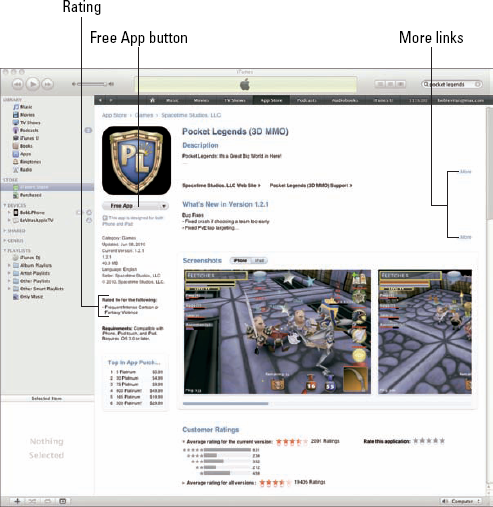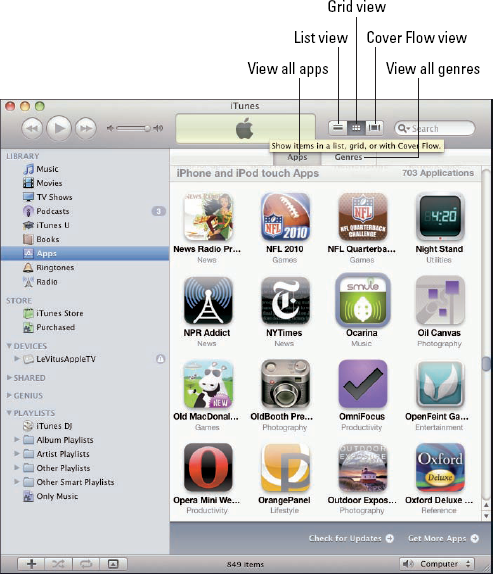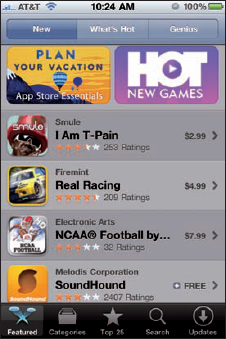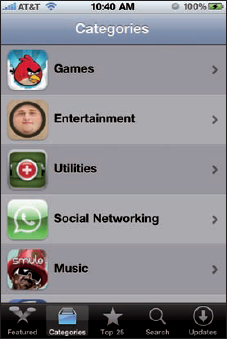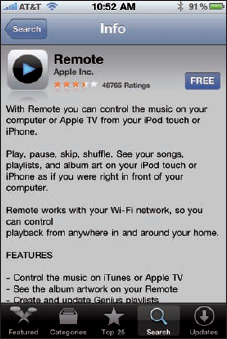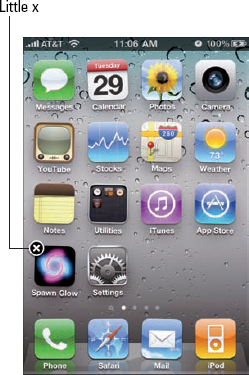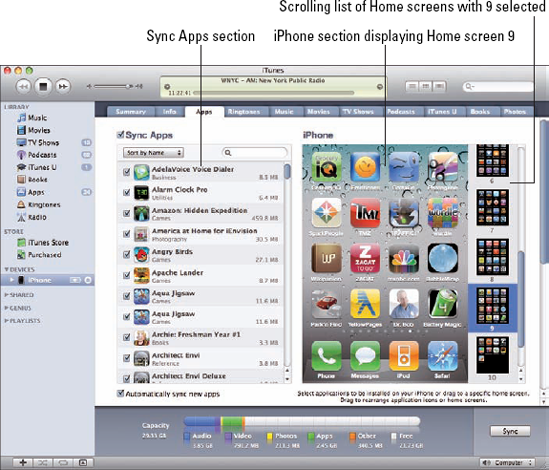Browsing for cool apps
Searching for specific apps
Getting apps onto your iPhone
Deleting and organizing your iPhone apps
One of the best things about the iPhone these days is that you can download and install apps created by third parties, which is to say not created by Apple (the first party) or you (the second party). At the time of this writing, more than 225,000 apps are available and well over 2,000,000,000 (yes, 2 billion) apps have been downloaded. Some apps are free, other apps cost money; some apps are useful, other apps are lame; some apps are perfectly well-behaved, other apps quit unexpectedly (or worse). The point is that of the many apps out there, some are better than others.
In this chapter, we take a broad look at iPhone apps. Don't worry: We have plenty to say about specific apps in Chapters 16 and 17.

You can obtain and install apps for your iPhone in two ways:
On your computer
On your iPhone
To use the App Store on your iPhone, it must be connected to the Internet. And, if you obtain an app on your computer, it isn't available on your iPhone until you sync it with your computer.
But before you can use the App Store on your iPhone or computer, you need an iTunes Store account. If you don't already have one, we suggest that you launch iTunes on your computer, click Sign In near the upper-right corner of the iTunes window, then click Create New Account, and then follow the on-screen instructions. Or, if you prefer to create your account on your iPhone rather than on your computer, follow the instructions near the end of Chapter 7.
Note
Let's put it this way: If you don't have an iTunes Store account, you can't download a single cool app for your iPhone. 'Nuff said.
Okay, start by finding cool iPhone apps using iTunes on your computer. Follow these steps:
Launch iTunes.
Click the iTunes Store in the source list on the left.
Click the App Store link.
Click the iPhone button at the top of the screen (as opposed to the iPad button).
The iPhone App section of the App Store appears, as shown in Figure 14-1.
After you have the iTunes App Store on your screen and have clicked the iPhone button so that you're looking at iPhone apps and not iPad apps, you have a couple of options for exploring its virtual aisles. Allow us to introduce you to the various "departments" available from the main screen.
The main departments are featured in the middle of the screen, and ancillary departments appear on either side of them. We start with the ones in the middle:
The New and Noteworthy department has 16 visible icons (starting with NCAA Football to My Photo Album in Figure 14-1), representing apps that are — what else? — new and noteworthy.
Only 16 icons are visible, but the New and Noteworthy department has more than that. Look to the right of the words New and Noteworthy. See the words See All? That's a link; if you click it, you'll see all apps in this department on a single screen. Or you can drag the scroll bar at the bottom of the New and Noteworthy section to the right to see more icons.
The What's Hot department also displays 16 icons (G4 to Duplicam Camera in Figure 14-1), representing apps that are popular with other iPhone users. Note the See All link and scroll bar for this department, either of which you can use to see more apps that are hot.
The Staff Favorites department, which appears below the What's Hot department, is not visible in Figure 14-1. The same drill applies to its See All link and scroll bar.
Warning
Apple has a habit of redecorating the iTunes Stores every so often, so allow us to apologize in advance if things aren't exactly as described here.
You also see a large display ad at the top of the screen (I Am T-Pain in Figure 14-1) and six featured links between the New and Noteworthy department and the What's Hot department (Hot New Games to iBooks in Figure 14-1). Some of these link to specific apps (such as The Elements); others link to a group of apps with a theme, such as Hot New Games, Soccer, and iBooks.
Three Top Charts departments appear to the right of the main ones: Paid Apps, Free Apps (one of our favorite departments), and Top Grossing Apps, which is not visible in Figure 14-1. The number-one app in each department is displayed as both an icon and its name; the next nine apps show text links only.
Finally, the black App Store button near the top of the screen is also a drop-down menu (as are most of the other department links to its left and right). If you click and hold on most of these department links, a menu with a list of the department's categories appears. For example, if you click and hold on the App Store link, you can choose specific categories such as Books, Business, Education, Entertainment, and others from the drop-down menu, allowing you to bypass the App Store home page and go directly to that category.
Browsing the screen is helpful, but if you know exactly what you're looking for, we have good news and bad news. The good news is that there's a faster way than browsing: Just type a word or phrase in the Search Store field in the upper-right corner of the main iTunes window, as shown in Figure 14-2, and then press Enter or Return to initiate the search.
The bad news is that you have to search the entire iTunes Store, which includes music, television shows, movies, and other stuff in addition to iPhone apps.
Ah, but we have more good news: Your search results are segregated into categories — one of which is iPhone Apps (refer to Figure 14-2). And, here's even more good news: If you click the See All link to the right of the words iPhone Apps, all iPhone apps that match your search word or phrase appear.
Tip
Click the little downward-facing triangle to the right of each item's price to display a drop-down menu. The menu for the first Flashlight app in Figure 14-2 lets you add the product to your wish list, send an e-mail with a link to this product, copy the link to this product to the Clipboard so you can paste it elsewhere, or share it on Facebook or Twitter.
Now that you know how to find apps in the App Store, this section delves a little deeper and shows you how to get additional info about an app that interests you.
To find out more about an app icon, a featured app, or a text link on any of the iTunes App Store screens, just click it. A detail screen like the one shown in Figure 14-3 appears.
This screen should tell you most of what you need to know about the app, such as basic product information and a narrative description, what's new in this version, the language it's presented in, and the system requirements to run the app. Click the blue More links to the right of the Description and What's New sections to expand them and see additional details.
Tip
Bear in mind that the app description on this screen was written by the app's developer and may be somewhat biased. Never fear, gentle reader: In the next section, we show you how to find reviews of the app written by people who have used it.
Notice that this app is rated 9+, as you can see below the Free App button shown in Figure 14-3. And just below the rating is the reason for that rating: Frequent/Intense Cartoon or Fantasy Violence.
Following is a list of the ratings as of this writing:
4+: Contains no objectionable material.
9+: May contain mild or infrequent occurrences of cartoon, fantasy, or realistic violence; or infrequent or mild mature, suggestive, or horror-themed content that may not be suitable for children under the age of 9.
12+: May contain infrequent mild language; frequent or intense cartoon, fantasy, or realistic violence; mild or infrequent mature or suggestive themes; or simulated gambling that may not be suitable for children under the age of 12.
17+: May contain frequent and intense offensive language; frequent and intense cartoon, fantasy, or realistic violence; mature, frequent, and intense mature, suggestive, or horror-themed content; sexual content; nudity; depictions of alcohol, tobacco, or drugs that may not be suitable for children under the age of 17. You must be at least 17 years old to purchase games with this rating.
One other feature of the detail pages that's worth mentioning is that most apps include one or more useful links, right below the app description. In Figure 14-3, one link goes to the Web site of the developer (Spacetime Studios), and the other links to the Pocket Legends Support Web pages. We urge you to explore such links at your leisure.
If you scroll down the detail screen, near the bottom you find a series of reviews by the app's users. (You can see the summary of customer ratings but not the actual reviews in Figure 14-3.) Each review includes a star rating, from zero to five. If an app is rated four or higher, it is probably well liked by people who own it.
As you can see, Pocket Legends has an average rating of 3½ stars based on 2,091 user reviews (19,405 reviews for all versions of the app). You'll find three or four recent reviews with their star ratings if you scroll down this page a little, and below them a link to even more user reviews.
Downloading an app is simple. When you find an app you want to try, just click its Get App or Buy App button. At that point, you have to log in to your iTunes Store account, even if the app is free.
After you log in, the app begins downloading. When the app has finished downloading, it appears in the Apps section of your iTunes library, as shown in Figure 14-4.
Tip
We are using the Grid view for the apps in Figure 14-4, but you can view your apps in two other ways, namely List view and Cover Flow view. To change views, click one of the three icons just to the left of the search field (labeled in Figure 14-4). Also note the two buttons below the icons, which say Apps (selected in Figure 14-4) and Genres. These provide two additional ways to look at your collection of apps; we suggest you try 'em all.
Every so often, the developer of an iPhone app releases an update. Sometimes these updates add new features to the app, sometimes they squash bugs, and sometimes they do both. In any event, updates are usually a good thing for you and your iPhone, so it makes sense to check for them every so often. To do this on your computer using iTunes, click the Check for Updates link near the lower-right corner of the App screen.
Tip
If you click the Get More Apps link at the bottom of the screen, you find yourself back at the main screen of the iTunes App Store (refer to Figure 14-1).
Finding apps with your iPhone is almost as easy as finding them by using iTunes. The only requirement is that you have an Internet connection of some sort — Wi-Fi or wireless data network — to browse, search, download, and install apps.
To get started, tap the App Store icon on your iPhone's Home screen. After you launch the App Store, you see five icons at the bottom of the screen, representing five ways to interact with the store, as shown in Figure 14-5.
The first three icons at the bottom of the screen — Featured, Categories, and Top 25 — offer three ways to browse the virtual shelves of the App Store.
The Featured section has three tabs at the top of the screen: New (refer to Figure 14-5), What's Hot, and Genius. These three tabs represent three different pages full of apps. Genius is a new feature and perhaps the most interesting tab of all — it suggests apps you might enjoy based on the apps currently installed on your iPhone.
The Categories section works a little differently: It has no tabs, and its main page contains no apps. Instead, it offers a list of categories such as Games, Entertainment, Utilities, Social Networking, and Music, to name a few, as shown in Figure 14-6.
Tap a category to see either a page full of apps of that type or a list of subcategories for that type. For example, the Games category offers subcategories such as Action, Arcade, Kids, Music, and Puzzle. Other categories have no subcategories — you'll go directly to the page full of apps when you tap them. To make your browsing easier, each category or subcategory page has three tabs — Top Paid, Top Free, and Release Date.
The Top 25 section works much the same as the Featured section. Its three tabs — Top Paid, Top Free, and Top Grossing — represent pages of the most popular apps that either cost money (paid and top grossing) or don't (free).
Now that you know how to find apps in the App Store, the following sections show you how to find additional information about a particular app.
To find out more about any app on any page, tap the app. You see a detail screen like the one shown in Figure 14-7.
Tip
Remember that the app description on this screen was written by the developer and may be somewhat biased.
To download an app to your iPhone, tap the price button near the top of its detail screen. In Figure 14-7, the price button is the blue rectangle that says Free. You may or may not be asked to type your iTunes Store account password before the App Store disappears and the Home screen, where the new app's icon will reside, appears in its place. The new icon is slightly dimmed, and appears with a blue progress indicator and the word Loading or Installing, as shown in Figure 14-8.
By the way, if the app is rated 17+, you see a warning screen after you type your password. You have to tap the OK button to confirm that you're over 17 before the app will download.
Warning
The app is now on your iPhone, but it isn't copied to your iTunes library on your Mac or PC until your next sync. If your iPhone suddenly loses its memory (unlikely) or you delete the app from your iPhone before you sync (as described later in this chapter), that app is gone forever. That's the bad news.
Tip
The good news is that after you've paid for an app, you can download it again if you need to — from iTunes on your computer or the App Store app on your iPhone — and you don't have to pay for it again.
After you download an app to your iPhone, the app is transferred to your iTunes Apps library the next time you sync your phone.
As mentioned earlier in this chapter, every so often the developer of an iPhone app releases an update. If one of these is waiting for you, a little number in a circle appears on the App Store icon on your Home screen as well as on the Updates icon at the bottom of the screen. Tap the Updates icon if any of your apps need updating.
If you tap the Updates button and see (in the middle of the screen) the message All Apps are Up-to-Date, none of the apps on your iPhone requires an update at this time. If an app needs updating, an Update button appears next to the app. Tap the button to update the app. If more than one app needs updating, you can update them all at once by tapping the Update All button in the upper-right corner of the screen.
Warning
If you try to update an app purchased from any iTunes Store account except your own, you're prompted for that account's ID and password. If you can't provide them, you can't download the update.
That's almost everything you need to know about installing third-party apps on your iPhone. However, you might find it helpful to know how to delete and organize apps.
You can delete an app in two ways: in iTunes on your computer or directly from your iPhone.
To delete an app in iTunes, click Apps in the source list and then do one of the following:
Click the app's icon to select it and then choose Edit

Right-click (Control+click on a Mac) the app's icon and choose Delete.
Either way, you see a dialog box asking whether you're sure you want to remove the selected app. If you click the Remove button, the app is removed from your iTunes library, as well as from any iPhone that syncs with your iTunes library.
You can't delete any Apple apps that came with your iPhone, but here's how to delete a third-party app on your iPhone:
Press and hold any icon until all the icons begin to jiggle.
Tap the little x in the upper-left corner of the app you want to delete, as shown in Figure 14-9.
A dialog box appears, informing you that deleting this app also deletes all its data, as shown in Figure 14-10.
Tap the Delete button.
Warning
Deleting an app from your iPhone this way doesn't get rid of it permanently. It remains in your iTunes library until you delete it from iTunes, as described earlier in this chapter. Put another way: Even though you deleted the app from your iPhone, it's still in your iTunes library. If you want to get rid of an app for good and for always after you delete it on your iPhone, you also must delete it from your iTunes library.
You can have up to 11 Home screens (or "pages") of apps. And if you're like many iPhone users, you'll soon have a substantial collection of apps in your iTunes library and on your iPhone. So let's look at a few ways to organize those apps for easy access.
First things first: On your computer, make sure you've selected your iPhone in the Devices section below the iTunes Store on the left side of the iTunes window. Then, click the Apps tab near the top of the window (shown in Figure 14-11).
You can organize your apps in the following ways:
In the iPhone section, you can click and drag an app icon to a new location on the same screen.
You can drag an app from the Sync Apps section on the left to any of the 11 screens in the Home screen list on the right, as long as the screen has no empty screens before it. In other words, you can drag an app to screen 7 as long as at least one app each is on screens 1 through 6.
You can change the order of screens in the Home screen list by clicking and dragging a screen upward or downward in the list and dropping it in its new location. After you have a few pages worth of apps, give it a try — it's easy and kind of fun.
To rearrange apps on your iPhone, first press and hold on any app until all the apps begin to jiggle and dance, and the little black "delete me" x's appear. Figure 14-12 shows the screen before (left) and after (right) moving an app. The app you press and hold doesn't have to be the one you want to move — any app will do.
To move an app after the jiggling starts, press it, drag it to its new location (other apps on the screen will politely move out of its way to make space for it), and release it, as shown on the right of Figure 14-12.
To move an app to a different Home screen after the jiggling starts, press the app and drag it all the way to the left or right edge of the screen. The preceding or next Home screen, respectively, will appear. Keep dragging the app to the left or right edge of each successive Home screen until you reach the screen you want. Then drop the app in its new location on that screen. If the screen already holds 16 apps, the last icon on the page will be pushed to the next Home screen. Be persistent — sometimes it takes a few tries to make the screens switch.
Tip
All these techniques for iTunes and iPhones work with apps in the dock: by default, Phone, Safari, Mail, and iPod. In Figure 14-12, we've replaced the Mail app with the Messages app and changed the positions of the iPod and Safari icons, so our dock probably looks different than yours.
Tip
You can add apps beyond the Home screen 11. To do so, just keep selecting check boxes for apps in the Sync Apps section after all 11 screens are filled. You won't be able to see the icons for these apps on any Home screen, so you'll have to access them via Spotlight search. On the other hand, because iOS 4 supports up to 2,112 apps on the 11 available Home pages (16 folders per page x 12 apps per folder x 11 available pages = 2,112 apps), you'll probably never need this tip. (If you've forgotten how to create folders, refer to the section on organizing icons into folders in Chapter 2.)
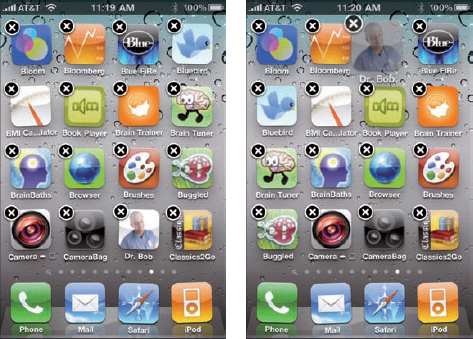
Figure 14.12. The way things were (left), and what happens when we drag the Dr. Bob icon from the bottom row to the top row.
Note
You use the same technique — drag one app on top of another app — to create folders in both iTunes and on your iPhone. And to place an app into an existing folder, you drag that app on top of the folder.
A few more facts about Home screens. We mention this elsewhere, but in case you missed it: The little dots above the four apps in the dock indicate how many Home screens you have. The white dot denotes the Home screen you're currently looking at. So, for example, the dots in Figure 14-12 tell us we're looking at screen 9 of 10 Home screens.
And last but not least, we'd be remiss if we didn't at least provide the following reminders. You can create folders that hold up to 12 apps each, put Spotlight to work to quickly find and launch apps no matter which Home screen they're on, and take advantage of multitasking to quickly switch between recently used apps. If you're hazy on any of these three concepts, we suggest that you flip back to Chapter 2, where they are expounded upon in full and loving detail.
There you have it — you now know everything you need to know to find, install, delete, and organize iPhone apps!
As Steve Jobs is so fond of saying in his keynotes, there is one last thing: In a few pages (Chapters 16 and 17, to be precise), to kick off the famous Part of Tens, we tell you about ten of our favorite free iPhone apps and ten that cost dough.
